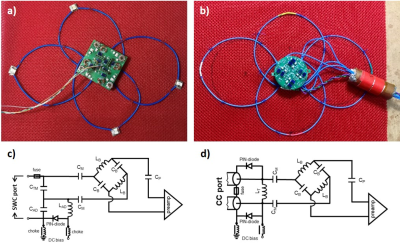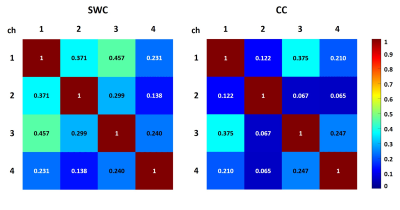Raphaela Czerny1, Michael Obermann1, and Elmar Laistler1
1High Field MR Center, Center for Medical Physics and Biomedical Engineering, Medical University of Vienna, Vienna, Austria
1High Field MR Center, Center for Medical Physics and Biomedical Engineering, Medical University of Vienna, Vienna, Austria
SWC and SC have similar Q behavior. For CC, Q
is lower. Coils were sample-noise dominated and robust against bending in terms
of frequency shift.
4-ch SWC and CC array showed similar geometric
and preamp decoupling. Noise correlation of the CC was lower. Solder joints limit
the flexibility of SWCs.

Figure 1: 4-channel
stranded wire coil array (a) and coaxial coil array (b) sewn onto fabric to maintain
coil overlap for optimal geometric decoupling. PIN bias cables are connected to
coil interfaces in the middle. In (b) a floating cable trap used in both setups
is shown. Circuit diagrams of coil interfaces are shown below for SWC (c) and
CC array (d), containing tuning, matching, active detuning, balun, phase
shifter, fuse and preamplifier. 1-channel coil interfaces did not include balun,
phase shifter and fuse.
